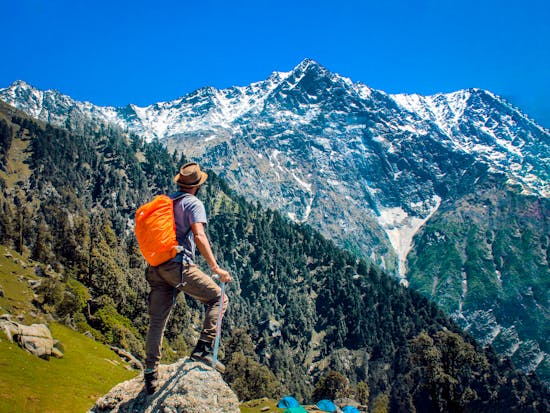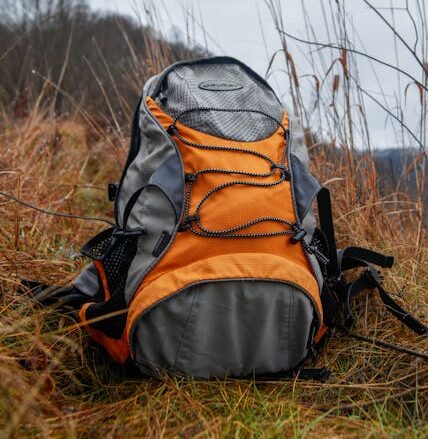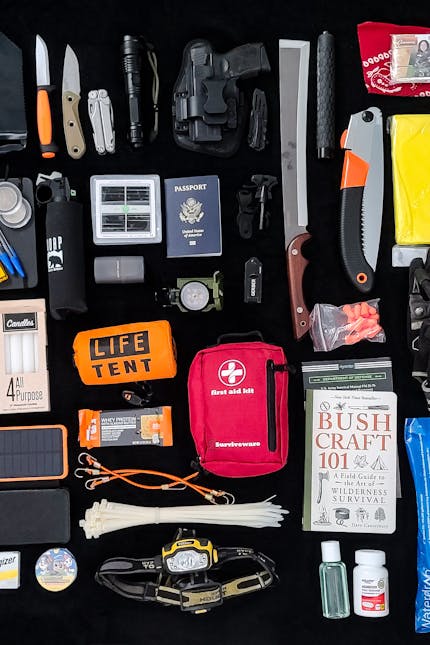
Whether you’re a seasoned hiker or a beginner, having the right gear can make all the difference.The best way to ensure you don’t forget an essential item when you’re starting out is to use a list.
My day hiking pack list is fool proof in getting it right. But before we jump into the list there are some important packing tips you should consider.
What Weight Should Your Pack Be?
I’m going to address a key aspect of day hiking that often gets overlooked until you’re halfway up the trail and feeling the strain: managing your pack weight. Why does it matter? Well, lugging around an unnecessarily heavy pack can turn an exhilarating hike into a grueling ordeal faster than you can say ‘summit’.
A simple guideline to follow is not to let your pack exceed 20 percent of your body weight. So, if you’re tipping the scales at 150 pounds (68 kg), your pack should be no more than 30 pounds (13.6 kg) for backpacking. For day hiking, you’ll want to aim even lower for enhanced comfort and mobility.
This isn’t just about the weight itself; it’s also about safety and comfort. The right balance can help you avoid overexertion, which can be a safety hazard, especially on challenging terrains. Simultaneously, carrying a lighter load can make your trip far more enjoyable and allow you to cover more ground with less effort.
To tailor your pack appropriately, consider your physical capabilities, the terrain, and weather conditions of your destination. Beyond personal ability, elements like elevation and climate can influence your pack’s contents and consequently, its weight. These factors will help determine your essentials and ensure you’re packing not just light, but smart.
This weight guide absolutely saved my bacon and back when I did a week’s hike around Mont Blanc. I carefully considered what I needed and had small containers of toothpaste, soap and shampoo. I packed the essentials only and had 1 change of clothes and I washed and dried my clothes daily. I had the lightest and most compact pack of the group and kept pace, even on the biggest of days.

What to Pack on a Day Hike
Essential Clothing and Footwear for Comfortable Day Hiking
For a comprehensive guide on clothing options, check out my Essential Hiking Gear For Beginners guide. It will help you make the right choice for a day of comfortable hiking.
Key Equipment for a Successful Day Hike
Here is my day hiking checklist of equipment that I believe is essential for a day of fun and safe hiking.
- Daypack: OK, I’m stating the obvious here.
- Water bottle or hydration bladder: My preference is a water bladder as I don’t have to stop to drink and it encourages me to drink more frequently thus avoiding dehydrastion. If using bottles, light weight is a must. I always pack extra water as a security. It is safer to have more that not enough.
- Food: Pack more than you think you’ll need—hunger can hit hard after a few hours of trekking.
- Map: This should be laminated or protected in a map case.
- Compass: No one plans on getting lost but carrying a compass and a detailed map can turn a potential disaster into a minor inconvenience.
- First aid kit: This is an essential, accidents happen .
- Headlamp: You never know what can happen and may end up having to walk in the dark. They are also handy for exploring caves.
- Whistle: To attract attention and is attached to your backpack for easy access.
- Watch: Analog is best for navigation.
- Matches and/or flint: Again this is about planning for the worst case.
- Emergency blanket or bivy: This is a light weight solo shelter that is used to protect you from the elements. On a day hike it would be used in an emergency siruation.
- Waterproof stuff sacks or pack liner: In my mind these are essential to keep clothes and items dry.
- Mobile or cell phone: This can be usefull is an emergency and also doubles as a camera.
- Sunglasses
- Toilet paper and trowel: Good hiking etiquette is to bury your poop.
- Multitool or Swiss Army knife
- Sunscreen
- Insect repellant
- Sanitizer
- Lip balm:
- Resealable bag for trash or rubbish

Optional Equipment for Day Hiking
The criteria I use when considering the items below is how long the hike is, its remoteness, difficulty and terrain. If I’m doing a short walk which is in a national park that is popular, close to suburbia and not extremely difficult then I would forego them for pack weight.
- Water filter or chemical treatment: Yes, it is possible to treat water to make it safe for human consumption. There are many hazards to drinking water from creeks and rivers.
- Satellite messenger: This can be a lifeline in remote areas
- Power bank to recharge a phone: Using tracking apps can chew battery power.
- Sit pad: This is a lightweight foam pad that is used to sit on when having a break. Personally, I don’t use one because of the room it takes in my pack.
- GPS device: This should not be relied upon as your only means of navigation.
- Lightweight absorbent towel: If I’m doing a hike with creek crossings then I consider this as in some instances taking shoes off is the only way of crossing without getting wet boots.
- Flip Flops or Crocs: If I know that I will be taking my shoes off to cross creeks these can be handy to wear and are lightweight.
- Cleats: These are worn over shoes to give extra traction. I don’t use them but have seen other walkers where there have been slippery sections of a hike.
- Notebook and pen/pencil: I use my phone if I need to write notes.
- Camera: My phone serves as a camera.
- Trekking poles: Some hikers swear by these as they do take weight of your knees on descents. Others find them a nuisance, particularly if a lot of scrambling over rocks is involved. They are handy for creek crossings, but so is a long stick. I have them but don’t often use them. Though, they usually fold up so can be easily carried just in case.
- Personal locator beacon (PLB): This is a small device that sends a distress signal to global satellites. I don’t have one but would only consider one if I was doing an off track walk in a remote area.
Smart Packing Tips for a Well-Prepared Hiking Experience
Now, after carefully selecting your gear and personal items, the final step is packing your daypack smartly. You can always adjust your approach down the road, but let’s talk about a few techniques that can help right now. Place the heaviest items at the bottom of your pack, close to your spine. This lowers the center of gravity and can help with balance on uneven trails.
Sharing equipment when day hiking isn’t just a great way to build camaraderie; it’s practical. If you’re hiking with friends, coordinate who brings what so you don’t end up with duplicates. This way, everyone carries a bit less, and the group still has everything necessary.
Line your pack with a heavy-duty plastic bag or use a specialized pack liner. This simple trick can keep your valuable items safe from unexpected rain showers. You can’t control the weather, but you can certainly prepare for it.
Carry your spare clothes and items in waterproof dry bags or dry sacks. A slip on a creek crossing can mean a wet backpack along with its contents.
Finally, make the items you’ll need frequently, like snacks, water, and sunscreen, easily accessible. It saves time and maintains your hiking rhythm when you don’t have to rummage through your pack. Remember, efficiency on the trail isn’t just about what you carry; it’s about how you carry it.
By considering the items on my day hiking pack list you are setting yourself up for a successful, safe and fun day of hiking. remember a good hiker is prepared for any situation that comes their way.
Happy Hiking!
What items do you consider essential for a day hike? Share your tips in the comments below!

Great post, Lyn! Your tips on managing pack weight and the detailed checklist for day hiking are incredibly useful. It’s easy to see how forgetting even one item could make a hike much less enjoyable. I particularly appreciated your advice on keeping the pack weight below 20% of body weight for comfort and safety. One question: How do you decide which optional items to include for different hikes? Do you have a rule of thumb or specific criteria that guide your decisions for each outing? Thanks for sharing your expertise!
Hi Hanna, thanks. Some things are must takes. Compass, map, headlamp, extra water and food. Things like the weather forecast or distance of the walk can influence what I bring. For example in winter I don’t take as much water than in summer. I have a really warm winter jacket but in summer use a lighter jacket. Where I’m walking also impacts what I bring. If it is a walk that is not far from houses, then I don’t take as much as I know help if something happened is close.
Great post, Lyn! Your article “Day Hiking Pack List – Tips For A Perfect Adventure” serves as a valuable guide for anyone planning a day hike. Your advice likely covers all the essentials, from safety to comfort, ensuring that hikers are well-prepared for a successful and enjoyable adventure.
You have very nicely emphasized the importance of a comprehensive pack list that covers all essential items, Preparing for varying weather conditions is crucial, Safety is a top priority, and advises carrying items like a first aid kit, whistle, multi-tool, and a fully charged mobile phone are useful.
One of the key insights you provide is the idea of personalizing your pack list based on the specific hike, weather, and your own needs. This adaptability ensures you’re not overburdened with unnecessary items but still have everything essential for the day.
By following your tips, hikers can focus on the beauty and excitement of the trail, knowing they have everything they need in their pack. Thank you for such a knowledgeable article.
Great article! Your day hiking pack list is comprehensive and well-thought-out. I completely agree with your emphasis on managing pack weight. It’s something that can make or break a hike. The 20% rule is a solid guideline, and I like how you tie it into both safety and comfort. Sharing gear with friends is a smart tip too; it’s a simple way to lighten the load while ensuring everyone’s prepared.
Personally, I never hit the trail without a water filter, especially on longer hikes. It’s such a small addition, but it gives me peace of mind knowing I have a backup in case my water supply runs low. Thanks for sharing these tips.
Hi Lyn,
Thanks for the great read! My wife and I love to hike, usually sticking to a couple of hours on well-trodden paths. However, when we were in Colorado, I was really tempted to venture off course just to soak in the stunning beauty of the area. I find myself drawn to the allure of exploring more remote trails, but I don’t have a GPS—just my phone, which often loses signal in those areas.
I’ve been considering investing in a GPS device to help me navigate better during our hikes. Could you recommend a budget-friendly, easy-to-use GPS for someone over 50? I want to ensure I stay safe while exploring those tempting trails and discovering new scenery without the stress of getting lost.
Your packing tips and gear recommendations are incredibly helpful, and I appreciate how you make hiking more accessible for everyone. It’s always reassuring to know I can prepare effectively before hitting the trail.
Keep up the fantastic content; I can’t wait to see what you share next! I’m looking forward to more tips that will enhance my hiking experience.
Opa
I remember one hike climbing two volcanoes. What was supposed to be a challenging half-day hike turned into a nerve-wracking 12-hour ordeal due to a sudden storm caused by a slip on the shale. I had to rest as I had damaged my ankle. As it got dark, it got I lost the trail.
Thankfully, I had some essentials from a worst-case hiking checklist that saved me. The emergency blanket was a literal lifesaver when the temperature dropped fast, and my headlamp helped me navigate the trail after dark.
You never know what will happen on a hike; hope for the best, but prepare for the worst.
Catherine, wow what a story. Being prepared for the worst is so important.